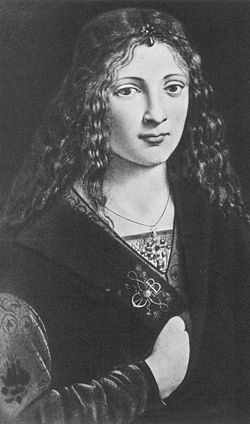
Bonifacio Bembo
Encyclopedia

Italian people
The Italian people are an ethnic group that share a common Italian culture, ancestry and speak the Italian language as a mother tongue. Within Italy, Italians are defined by citizenship, regardless of ancestry or country of residence , and are distinguished from people...
painter and miniaturist of the early-Renaissance
Renaissance
The Renaissance was a cultural movement that spanned roughly the 14th to the 17th century, beginning in Italy in the Late Middle Ages and later spreading to the rest of Europe. The term is also used more loosely to refer to the historical era, but since the changes of the Renaissance were not...
period.
Born in Brescia
Brescia
Brescia is a city and comune in the region of Lombardy in northern Italy. It is situated at the foot of the Alps, between the Mella and the Naviglio, with a population of around 197,000. It is the second largest city in Lombardy, after the capital, Milan...
and formed in the late Gothic school, he was influenced by the Renaissance style. After his knowledge with Gemistus Pletho
Gemistus Pletho
Georgius Gemistus — later called Plethon or Pletho — was a Greek scholar of Neoplatonic philosophy. He was one of the chief pioneers of the revival of Greek learning in Western Europe...
, he absorbed the latter's Neoplatonic
Neoplatonism
Neoplatonism , is the modern term for a school of religious and mystical philosophy that took shape in the 3rd century AD, based on the teachings of Plato and earlier Platonists, with its earliest contributor believed to be Plotinus, and his teacher Ammonius Saccas...
ideals. He was also active in Cremona.
His paintings include the frescoes of the church of Sant'Agostino di Cremona in Cremona
Cremona
Cremona is a city and comune in northern Italy, situated in Lombardy, on the left bank of the Po River in the middle of the Pianura Padana . It is the capital of the province of Cremona and the seat of the local City and Province governments...
and the portrait of Francesco I Sforza
Francesco I Sforza
Francesco I Sforza was an Italian condottiero, the founder of the Sforza dynasty in Milan, Italy. He was the brother of Alessandro, with whom he often fought.-Early life:...
and his wife Bianca Maria Visconti
Bianca Maria Visconti
Bianca Maria Visconti was Duchess of Milan from 1450 to 1468.-Early years:Born near Settimo Pavese, Bianca Maria was the illegitimate daughter of Filippo Maria Visconti, Duke of Milan and last of the Visconti rulers, and Agnese del Maino, the only person the shy, secluded Filippo ever loved...
(both from 1462), now in the Pinacoteca di Brera of Milan
Milan
Milan is the second-largest city in Italy and the capital city of the region of Lombardy and of the province of Milan. The city proper has a population of about 1.3 million, while its urban area, roughly coinciding with its administrative province and the bordering Province of Monza and Brianza ,...
. He also painted for the cloister
Cloister
A cloister is a rectangular open space surrounded by covered walks or open galleries, with open arcades on the inner side, running along the walls of buildings and forming a quadrangle or garth...
of La Colomba at Cremona
Cremona
Cremona is a city and comune in northern Italy, situated in Lombardy, on the left bank of the Po River in the middle of the Pianura Padana . It is the capital of the province of Cremona and the seat of the local City and Province governments...
.
Bembo is usually considered the author of one of the famous Visconti-Sforza tarot decks, whose symbolism reflects his interest in Neoplatonism. He said to have died in 1498, while other sources cite before 1482. He was the sibling of Benedetto Bembo and uncle of Giovanni Francesco Bembo
Giovanni Francesco Bembo
Giovanni Francesco Bembo was an Italian Renaissance painter from Cremona, mainly active from 1515-1543. He apprenticed with Boccaccio Boccaccino. In 1515, he painted two frescoes: Presentation in the Temple and an Adoration of the Magi for the Duomo of Cremona. He painted in 1524, an altarpiece for...
, both painters.

